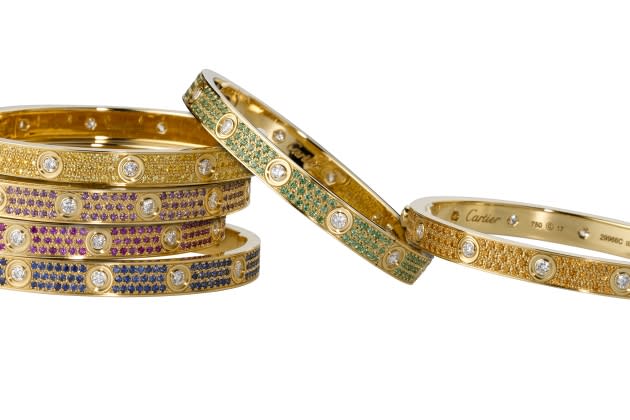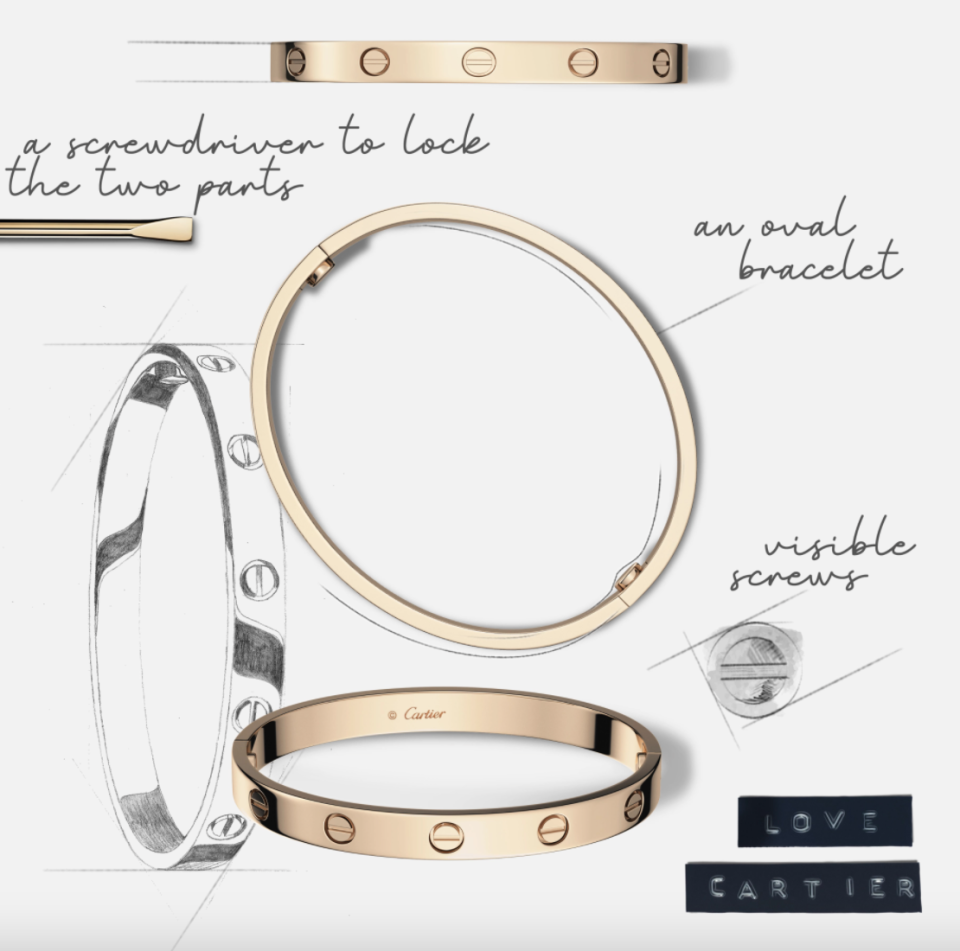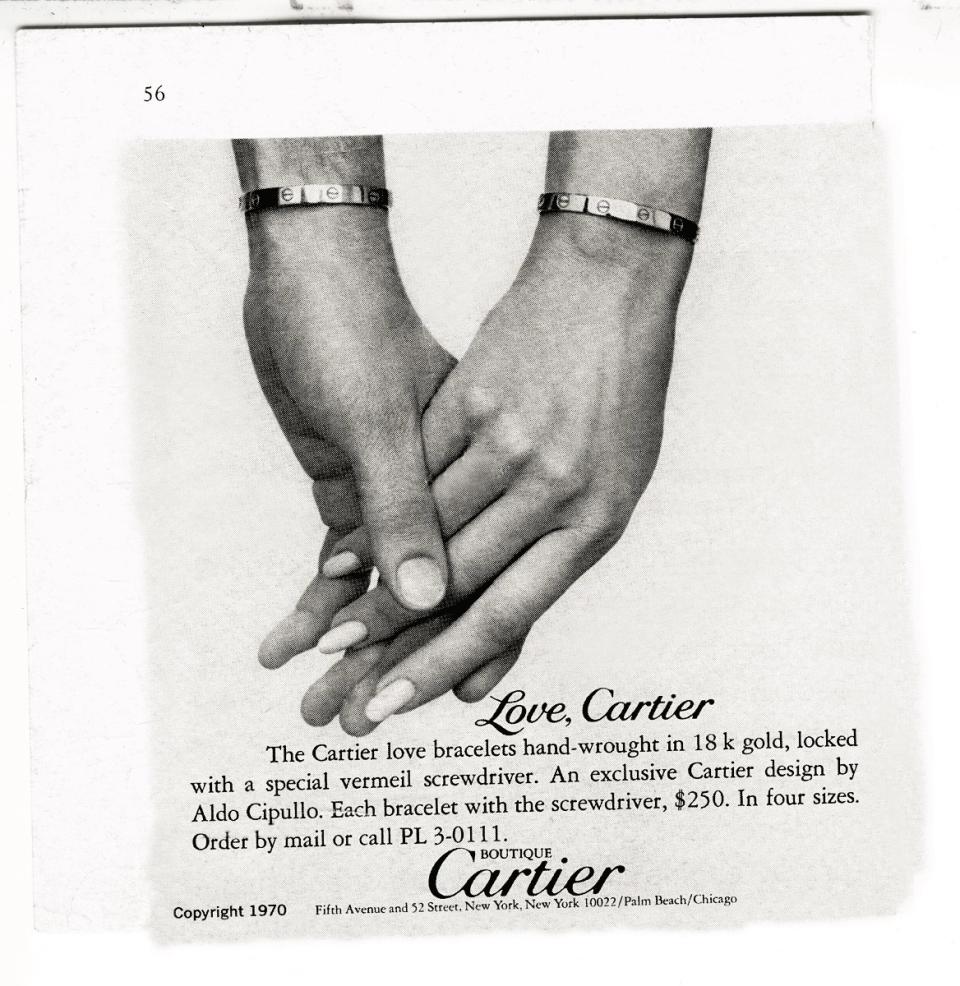Everything to Know About the Cartier Love Bracelet

Declaration of love comes in many forms, however none is more practiced than the material allure of buying jewelry for a loved one. Cartier’s timeless Love Bracelet has been a permanent staple on the wrists of celebrities, couple and single people alike for more than 50 years and has become a quintessential part of the iconic jeweler’s history.
The History of Love
In 1969, Italian-born Aldo Cipullo designed the Love Bracelet in New York City, following his own personal experience with heartbreak. The result: two thin C-shaped pieces of precious metal adorned with 12 imprinted screws — a nod to the bezel of the Cartier Santos watch — around the band, with two of them functioning as a locking mechanism around the wearer’s wrist. The oval shape of the bracelet is crafted to model the curvature of a wrist, in lieu of a circular bangle or shapeless chain.
More from WWD
Before joining Cartier, Cipullo worked with prominent jewelry fixtures, David Webb and Tiffany & Co, but it wasn’t until the end of his relationship with the latter in 1969 that he designed the evocative bracelet. After his design was rejected from Tiffany’s, Cipullo brought his template to Cartier New York. At that time, the once family-owned French brand had been sold and broken off into different international branches — Cartier London, Paris and New York. It wouldn’t be until 1976 that all three sectors were reunited, becoming Cartier Worldwide.
The initial design came to him on one sleepless night he recalled in interviews: “It was 3 o’clock in the morning, I was feeling very sad. I wanted something nobody could take away from me.” Drawing inspiration from the physical exemplification of something as powerful as a chastity belt, Cipullo wanted to showcase his language for love in a lasting form. When others saw it, he believed, they’d know that that person was in a committed relationship.
The ritual of putting the bangle on is just as intimate as the reasoning behind the purchase. Its design is made to be put on with the assistance of someone else, specifically a loved one with whom forever seems possible. Ultimately, the Cartier Love Bracelet was created as an industrial piece and a symbol of love to one’s paramour, in place or in conjunction with an engagement ring. “What modern people want are love symbols that look semi-permanent,” Cipullo said. “Or, at least, require a trick to remove. After all, love symbols should suggest an everlasting quality.”
During the late ’60s and early ’70s, chains, statement earrings, beaded styles and interchangeable pieces were popular, which made the simple sturdy gold bangle stand out among the trends of the time. Reminiscent of tools and fixtures that you’d customarily find in a hardware store, Cipullo’s style was akin to everyday living, but in a grandeur interpretation that Cartier was able to reproduce using the highest-quality materials.
Construction
Throughout its multidecade history, the Love Bracelet has evolved at Cartier to encompass an entire Love collection that includes rings, earrings, necklaces and different bracelet styles, all in the same design first created by Cipullo.
The first rendition of the Cartier Love Bracelet featured styles with screws that could be completely removed and tightened, heightening the need of another person to put it on. In contrast, introduced in 2011, the new styles had the screws adjourned to the openings to avoid losing one. Additionally, all bracelets come with a screwdriver. To continue the grand gesture of showing one’s love, one partner would wear the bracelet and the other the small gold screwdriver on a necklace chain. Rumors state that at first, Cartier would only sell the bracelets as a duo for couples to wear together.
Cipullo once remarked, “Design has to be part of function. That’s the secret of success. When you have function and design, married together, you always have a successful item.”
Initially, the Love bracelets were plated in gold, whereas current styles are made from luxury materials, namely 18-karat gold (available in yellow, white and pink) or 950 platinum. In true Cartier fashion, the line has extended to include pieces adorned with diamonds ranging from approximately 0.10 carats in a single diamond to 0.95 carats for a 177 pavé diamond setting.
While the Cartier Love Bracelet was originally sold for only $250, as popularity and market value for the well-known statement piece rose, so did the price. Current bracelets range from $4,450 to $62,000, depending on materials and the number of diamonds utilized.

Often Replicated Never Duplicated
As early as 1998, Cartier has entered numerous lawsuits and court proceedings with companies around the world to protect the copyright for their famous bracelet. An active trademark deal filed in 1974 states that the famous French brand has a copyright on the name “Love Bracelet” specific to the company’s well-known spelling with the line drawn through the letters “O” and “E.” Recently, in 2019, Cartier tried to obtain a trademark on the word “love” altogether but was stopped by Singaporean courts. While Oscar Wilde might have said that, “Imitation is the sincerest form of flattery that mediocrity can pay to greatness,” Cartier is adamantly against replica designs and full-blown knockoffs.
A Pop Culture Status Symbol
A popular staple amongst celebrities, the oval bangle has been seen on the wrists of famous couples such as Elizabeth Taylor and Richard Burton, Steve McQueen and Ali MacGraw (though it was given to her by her second husband, producer Robert Evans) and allegedly even the Duke and Duchess of Windsor. Despite each relationship’s varying degree of longevity, at one point it seemed every celebrity duo was donning a Cartier Love Bracelet as part of their everyday wardrobe. More recently, celebrity couples such as Justin Bieber and Hailey Bieber, Prince Harry and Meghan Markle and Kim Kardashian West and Kanye West have donned the bracelet.
The impact of the Love bracelet is evident throughout Cartier’s history. In 2006, WWD reported that Frédéric de Narp, the then-president and CEO of Cartier North America successfully petitioned then-New York Mayor Michael Bloomberg to designate June 8 “Declare Your Love Day.” This was celebrated between 2006 and 2011, with a yearly charity dinner in collaboration with various celebrities, such as Eva Mendes, Salma Hayek, Nicole Richie, Sarah Jessica Parker and Liv Tyler. Each year, the bracelet design differed, but the main style featured a silk chord structure with an 18-karat gold ring that had the bevel screw head stamped into the metal. Also reported by WWD in 2008, at the time more than $2.3 million had been donated to more than 16 global charities.
The Love Bracelet’s Cultural Impact
However, in the new era of social media and online influencers, Cartier saw a dramatic shift in the demographic of customers purchasing the bracelet that had once been synonymous with love for such a long time. In 2014, multihyphenated brand owner Kylie Jenner posted an image on Instagram of her wearing more than $50,000 worth of Cartier Love Bracelets on her one wrist, which many publications noted were more than a semester’s worth of tuition for a college student. At only 17 years old, Jenner already had a huge following and impact among Millennials, and it could be reasonably argued that her Cartier stacked bracelet style inspired a slew of young influencers and fans to purchase a bracelet.
A quick (and endless) scroll on a YouTube search for the Cartier Love Bracelet will reveal hundreds of thousands of videos featuring the young clientele that Cartier has been attempting to tap into since its reorganization in the early ’70s. Videos featuring influencers and prospective socialites reviewing the historical cuff reach thousands in views — almost as much as the subsequent videos of these young individuals getting “stuck” in their purchase. It is likely that neither Cipullo nor Cartier could have imagined that the bracelet has become a mainstay from Gen X to Gen Z. What was once a symbol of love, albeit an expensive one, has snowballed into a social marker worn by many and seen by millions more throughout Instagram, YouTube and TikTok.
TSA agents shared in 2016 that one of the “most annoying” things they had to deal with at airport security was the Cartier Love Bracelet. For this reason, Cartier even wrote in their instruction manual the following: “Please kindly note: As your bracelet can only be attached or removed using the dedicated screwdriver, we recommend you not to wear it when traveling by plane so as to avoid any inconvenience when proceeding through security checkpoints.”
In 2021, Cartier honored the man who re-envisioned love through the book “Cipullo: Making Jewelry Modern.” Written by Vivienne Becker, jewelry expert and historian, and Cipullo’s brother and jeweler, Renato Cipullo, the pages take a deeper look at Cipullo’s life, artistry in the industry and his work with Cartier — namely the beloved 18-karat gold Cartier Love bracelet and his creative follow-up, the nail-inspired Juste un Clou.
Currently, as the most searched piece of jewelry on Google, the Cartier Love Bracelet has seen an evolution from a representation of love to a symbol of status. This bracelet carries decades of history and an immortal impression on the fashion and jewelry industry.
Sign up for WWD's Newsletter. For the latest news, follow us on Twitter, Facebook, and Instagram.


